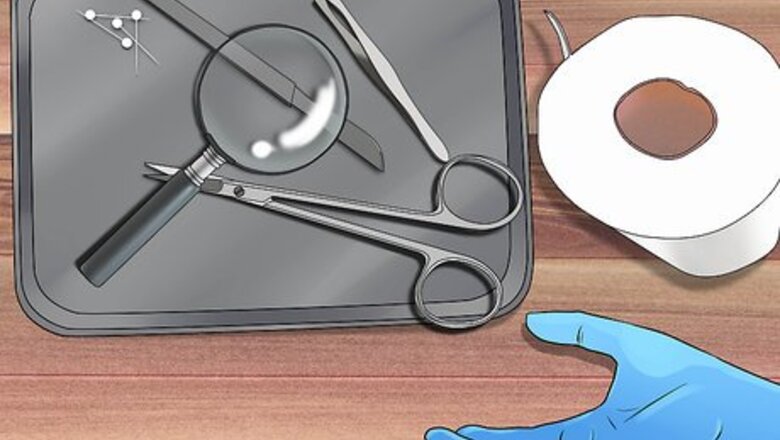
views
Preparing for the Dissection
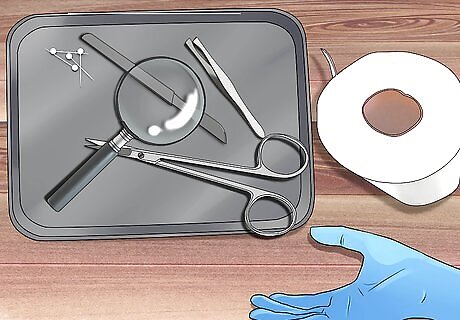
Gather the necessary materials. To dissect a squid you need the proper tools and materials: a scalpel, some tweezers, a pair of dissection scissors, pins/toothpicks, a dissection pan, hand lenses/magnifying glass, gloves, and paper towels. The squid itself can be purchased from a local bait shop, seafood market, or a laboratory science company. The rest of these tools should be found in your school’s science lab and provided to you.
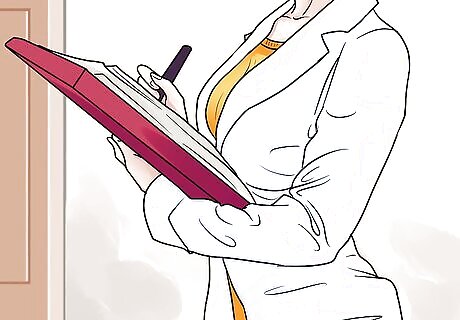
Cover up your clothes. Dissecting anything can get messy. Make sure you cover up your clothes with a lab coat or some other type of smock to keep yourself clean of squid guts. Closed-toe shoes and pants should also be worn on dissection day. Eye goggles are recommended to prevent spray from getting into your eyes.
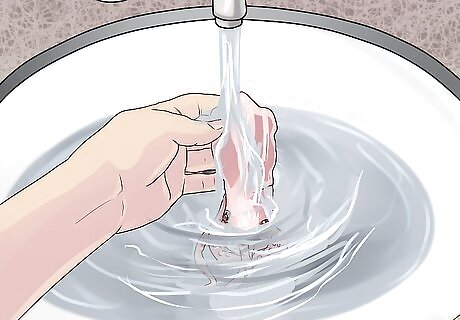
Rinse the squid and thaw if necessary. If you received the squid frozen and in a preservative, you will have to thaw it before you can begin. Take it out the night before and let it thaw for at least eight hours. Placing it in a warm water bath will speed up this process. Once the squid has thawed, remove it from the packaging and thoroughly rinse it off to remove the preservative.
Dissecting the External Anatomy
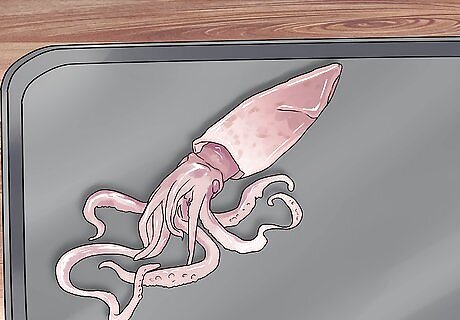
Observe the squid as a whole. Identify the dorsal (back) side of the squid. The dorsal side has darker shading than the ventral (front) side. Place your squid on the dissection plate with darker dorsal side facing up. Identify the following features of the squid: Mantle: The mantle is the part of the squid’s body that is not the arms and tentacles. It is just above the head of the squid, and it holds all of the squid's internal organs. Funnel: The funnel is the part of the squid that allows it to move, squirt ink, lay eggs, and excrete waste. It pumps seawater out of the mantle through the funnel to propel itself forward. Fins: A squid has two fins at the very top of the mantle and uses them to direct its movements through the water. Chromatophores: Chromatophores are tiny dots on the skin of the squid that can be expanded and contracted by the squid to change the color of its skin. These dots are actually small sacs filled with pigment (color).
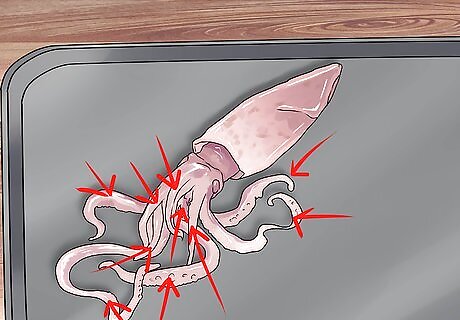
Count the number of arms and tentacles. Spread out the arms using the tweezers or a toothpick and count how many there are. You may notice that there are two different types of arms: some are longer than others. There should be eight shorter arms and two longer ones. The shorter projections that have suckers all along them are called arms. The longer projections with suckers only at the ends are called tentacles. The tentacles are used to capture prey, while the suction cups on the arms are used to hold onto the prey and bring the food to the mouth.
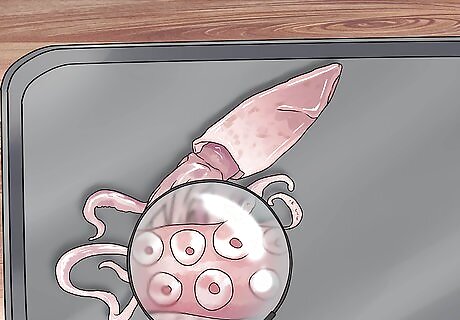
Look at the suction cups with a magnifying glass. Cut off one of the suckers from a tentacle and observe it through the magnifying glass. If you have access to a microscope, look at it under this as well. You should notice that the suction cup actually has small teeth all along its outer edge. These are used to hold onto prey after capture to prevent its escape. Observe multiple suckers from both the arms and the tentacles to see if they differ.
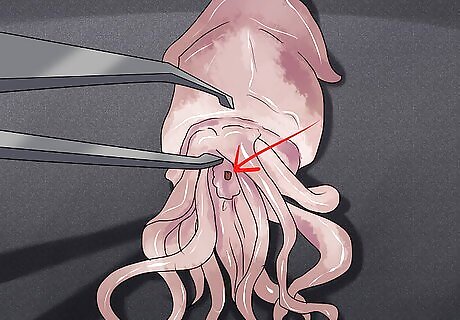
Locate the beak inside the squid’s mouth. The mouth can be found in the center of the arms. Hold the squid so the top of the mantle is pointing down at the dissection pan. Then, locate the beak inside the squid's mouth. The beak is surrounded by a muscular mass called the buccal bulb. Cut around the base of the arms to remove the buccal bulb and the beak. Notice how sharp the beak is. It is used to tear prey apart. Look for the radula inside the beak. The radula has rows of sharp teeth on it that helps the squid shred its food as it swallows it. The buccal bulb is also attached to a long tube that is the squid’s esophagus.

Cut open the eyes. Look at the size and location of the eyes on the squid. You’ll notice they are quite large in comparison to their head. Snip the cornea (the soft membrane covering the eye) and find the lens inside. Using your finger, you should feel something hard inside the eye, this is the lens. Pull it out and compare the lens of the squid to that of a round human lens. Squids cannot see colors, but can see gradients of light and dark.
Dissecting the Internal Anatomy

Cut up through the mantle. Flip the squid over so that the ventral (front) side of the squid is now facing up. Using the dissection scissors, cut down the middle of the mantle, starting at the funnel and finishing at the top. Try to hold the top of the mantle up while cutting to avoid cutting through any of the internal organs. Once you have sliced the mantle, you can fold the sides over and view the internal organs of the squid. If it doesn’t fall open, there may be cartilage still holding the mantle in place. These pieces can easily be pulled apart with your fingers.

Identify the gender of your squid. At the top of the mantle cavity are the gonads (sex organs) of the squid. In males, these will be the testes, while in females, they will be ovaries. The gonads will be by the fins of the squid and can be used to identify the gender. Female squid will have eggs inside the ovaries that are yellowish in color and look like jelly. Females also have a large white organ called the nidamental gland above the ovary, which helps secrete the egg cases. Male squid will have sperm which is a cloudy white with a watery feel.

Locate the two gills and gill-hearts. On either side of the body cavity, there will be a feathery-like structure that are the gills of the squid. These are used for breathing and getting oxygen throughout the squid’s body. A squid has three hearts and two of them are located at the base of each gill. Technically, they are called branchial hearts, but they are often referred to as the gill-hearts. The third heart is called the systemic heart. It is larger and located between the two gill-hearts. It may be obscured by the kidney, which is in the same location and may cover the heart.
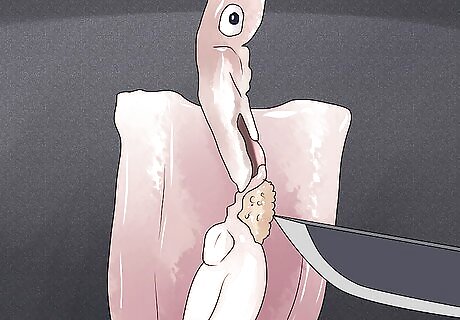
Dissect the digestive system. The digestive system of the squid consists of the esophagus, stomach, caecum, intestine, anus, and funnel retractor muscles. You probably pulled the esophagus out when you cut out the buccal bulb and the beak. The esophagus connects to the stomach which can be difficult to find. It is generally found near the base of the gills. The caecum, intestine, and anus process the food and connect to the funnel, where the waste is disposed of.

Find the ink sac. The ink sac is attached the intestine of the squid. It is relatively easy to find given its dark color. It will vary in size depending on how much ink is inside the sac. Remove the sac by cutting just above and below it being careful not puncture it. The ink is used as a defense against predators: a squid will squirt it into the water and then turn black using its chromatophores to blend in. Once it is removed, you can pierce it and write your name with squid ink!
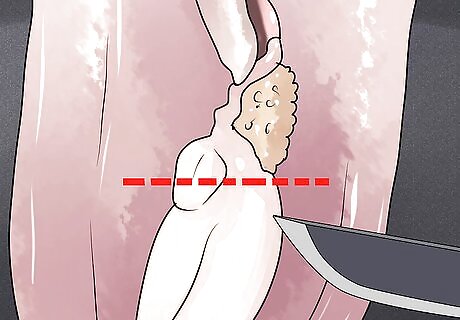
Remove the pen. The pen is a stiff internal structure that is used to support the squid as it moves through the water. It is found underneath the muscles and organs, starting near the reproductive organs. It can be removed by gently tugging the tip until it comes out. Take note of the flexible nature of the pen. It is similar to the stalk of a feather, or a thin, flexible plastic.
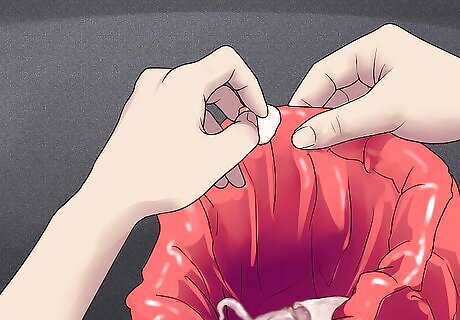
Clean up. Once you have finished dissecting your squid, place all of the dissected organs back into the cavity of the squid and dispose of it. Carefully clean the tools and wipe down your work surface with a cleaning solution. Wash your hands after finishing the clean-up. Complete any assignments associated with the dissection.

















Comments
0 comment